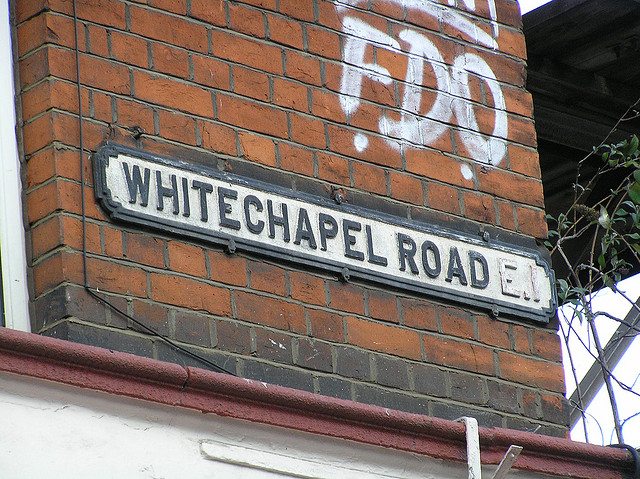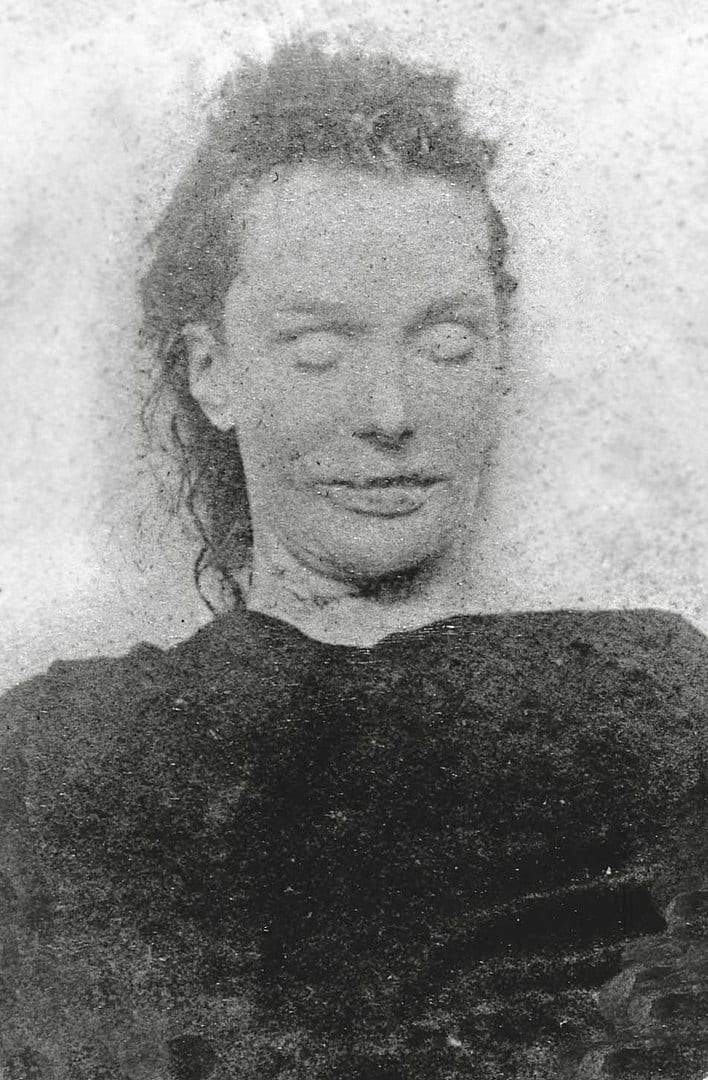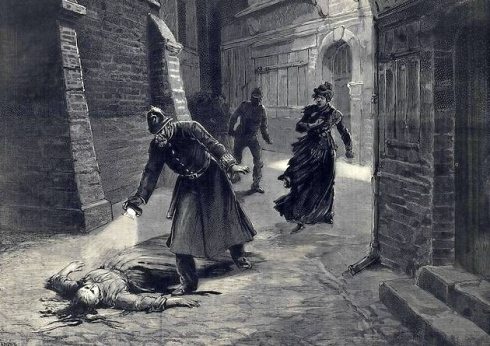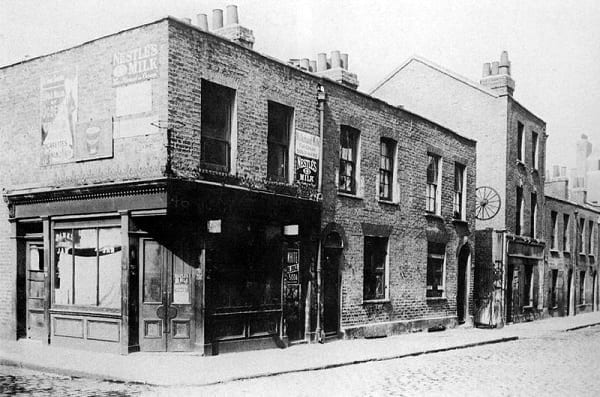In this post, we explain who Elizabeth Stride was and how and where she became an accepted victim of Jack the Ripper.
Who Was She?
Born Elisabeth Gustafsdotter in November 1843, she was the daughter of a farmer and his wife.
Originally, she worked as a domestic servant in Sweden where she was born.
However, by March 1865 she is recorded by police as a registered prostitute, had been treated twice for venereal disease, and had given birth to a stillborn girl.
In 1866, Elisabeth moved to London and in 1869 married a ship’s carpenter named John Thomas Stride. Together, they opened a coffee room in Poplar, East London.
(As a note it was around this time, Elizabeth began to be known as ‘Long Liz’ either for her height, a pun with her surname being stride, or because of the shape of her face)
There is not much information about their business until 1875 when it was taken over by a man named John Dale.
The following years of Elizabeth’s life are shrouded in fabrication.

Liz claimed she had given birth to 9 children throughout her marriage, although there are no records to back this up
Then, in 1878, a saloon steamship collided with another boat in the Thames, with casualties of over 600 people.
Liz began telling people that her husband and children were killed in the disaster and that she had been on the boat, also, and was injured trying to escape.
She said that she was kicked in the mouth and suffered permanent damage, although later her autopsy would prove this was not true.
Today, it is thought that Liz began telling these stories to cover the breakdown of her marriage and also to garner sympathy so the church would give her more money. By 1881, Liz and her husband had permanently separated.
How Did She End Up in Whitechapel?
After 1881, Elizabeth is documented as bouncing between workhouses and lodging houses in the East End, where workhouses existed in abundance for the impoverished citizens of the area.
To make ends meet, Liz took up sewing work and casual prostitution.
Throughout the mid-1880s, she also engaged in a long on-again-off-again relationship with a local man, Michael Kidney whom she occasionally lived with in his house on Devonshire Street, off Commercial Road in the Whitechapel district.

He told police that Liz would routinely disappear from his home and go on drinking benders, which is backed up by police records showing that she was picked up in the Whitechapel area 8 times for drunk and disorderly conduct.
It’s also worth noting that Liz reported Michael to the police for domestic violence, but at her failure to appear in court, the case was dropped.
How Did She Die?
On the 29th of September 1888, Liz was cleaning rooms in her lodging house at 32 Flower and Dean Street.
The deputy keeper paid Liz sixpence for her work and Liz left to spend it at the nearby pub, the Queen’s Head.
She returned to the lodging house, dressed “ready to go out” according to another lodger, and departed at 7:30 pm for the final time.
Liz was next seen at 11:00 pm sheltering from the rain in a doorway of the pub by two laborers, J. Best and John Gardner.
She was with a man, around 5ft 5in tall who was wearing a black morning suit and a hat.
The witness claimed the couple were hugging and kissing and the workmen invited them into the pub to have a drink, which the man refused.
They then called out to Liz in a teasing manner, “Watch out, that’s Leather Apron getting ‘round you!” On hearing that, the couple left “like a shot.”
She was next seen at 11:45 on Berner street, with a short gentleman wearing a short coat and a sailor’s hat who was heard saying to Liz, “You would say nothing but your prayers.”
Next, she was witnessed just after midnight by PC William Smith near Dutfield’s Yard, opposite the International Working Men’s Educational Club, where she was standing with a man approximately 28 years old, with a dark complexion and mustache.
Finally, around 12:45 a man named Israel Schwartz reported seeing a man stop to speak to a woman (later identified as Elizabeth) who was standing in the gateway near the Club.
He tried to pull the woman into the street but when she resisted, he threw her down and turned to a man standing on the opposite side of the street and called out, “Lipski.”
Schwartz decided to walk on and realized he was being pursued by the man who had been standing on the street so he began to run, and was then not followed again.
This was the last living sighting of Elizabeth Stride.
At 1:00 am, Louis Diemschutz entered Dutfield’s Yard driving his cart and pony. The pony shied away and refused to proceed - but Louis could not see what the problem was as it was so dark.
He probed about in the blackness and touched a body which, somebody Louis believed was either drunk or asleep.
He entered the Club to get help in rousing the woman, but when he and two other men returned to the Yard with a lantern they discovered that the woman was dead, with her throat cut.
Her body was still warm and Louis forever believed that the killer had been in the yard when he arrived with his Pony, and it was only the darkness that stopped him coming face to face with Jack the Ripper.
Jack the Ripper’s Third Victim
A doctor was called who pronounced Liz dead at 1:16 am. The coroner reported that her throat was deeply gashed, six inches in length. However, this was the extent of Elizabeth’s injuries.

A doctor was called who pronounced Liz dead at 1:16 am. The coroner reported that her throat was deeply gashed, six inches in length. However, this was the extent of Elizabeth’s injuries.
This meant that her death matched those of the three previous victims in that the day of the week, time, type of site, characteristics of the victim, and method of murder were all the same.
But there was no mutilation to her body - the hallmark of Annie and Mary Anne’s murders.
At first, this seemed curious, but if Louis Diemshutz was correct, he may have interrupted the murder before he was able to complete his work.
This theory also seems to check out and was believed by investigators, given what would happen an hour later, within walking distance of Elizabeth’s murder - the brutal slaying and mutilation of Catherine Eddowes.
Where Did Elizabeth Die?
Dutfield’s Yard was a small courtyard situated next to the International Working Men’s Club at No. 40 Berner Street.
At the time, Berner Street contained a variety of buildings and was mostly residential, aside from the Club.
Today, the street is called Henriques Street and the housing where Elizabeth died has been swept away to clear space for the construction of a primary school.
To learn more about Annie’s tragic death and the street where it happened, consider joining our Jack the Ripper walking tour, or download our GPS-enabled Audio Guide.
Suspects
The fledgling police force now knew they had a repeat murderer on their hands.
The list of accused and suspected men was growing, although the so-called “Leather Apron” was still the widely recognized guilty party by the public in the East End, as referenced by the workmen teasing Liz about him in the hours before she died.
80,000 leaflets requesting information had been distributed to the neighbourhood and over 2000 lodgers would be interviewed by Police.
Who Was Jack the Ripper?
Jack the Ripper is the name given to an unidentified serial killer who was active in the Whitechapel area of East London in 1888.
At first, the killer was known as the “Whitechapel Murderer” and “Leather Apron” until a taunting letter arrived at a police station, in which the writer claimed to be the killer who signed his note with the name “Jack the Ripper.”

The victims of Jack the Ripper are all linked together by the following:
- All were prostitutes
- All had their throats slashed
- All suffered mutilation to their bodies
- At least three had the removal of organs after they died
No witness has ever come forward with a clear, verifiable description of the killer.
With the killings taking place during the fledgling years of police crime scene investigation, much evidence has been contaminated or lost, meaning the exact identity of the killer is unlikely to ever be known.
You might care to read our post title, Who Was Jack the Ripper, for a more in-depth exploration.
The Canonical Five
Before Mary Ann Nichols was killed at the end of August 1888 there had already been a large number of attacks against women in the East End area.
There are 11 separate murders that had been documented as part of the “Whitechapel Murders.”
Historians often disagree as to if some of the other murders were the work of Jack the Ripper but most experts point to five victims as the only confirmed victims of Jack the Ripper.
They are identified as such by the deep throat slashes, abdominal and genital mutilation, and the progressive facial mutilations of the victims as the modus operandi of Jack the Ripper.
The victims in order of their murder are:
- Mary Ann Nichols
- Annie Chapman
- Elizabeth Stride
- Catherine Eddowes
- Mary Jane Kelly
Be sure to read our full post on the victims of Jack the Ripper.
Jack the Ripper Tours
If you would like to learn more about Jack the Ripper, consider taking one of our regularly scheduled walking tours of the Whitechapel area.
On our Jack the Ripper Tour you will visit crime scenes, learn about the women who were brutally and tragically killed, hear descriptions of the acts committed by the culprit, and walk in the footsteps of the world’s most famous serial killer.
If you can’t attend our walking tour, consider downloading our GPS-enabled Self-Guided Audio Tour.










